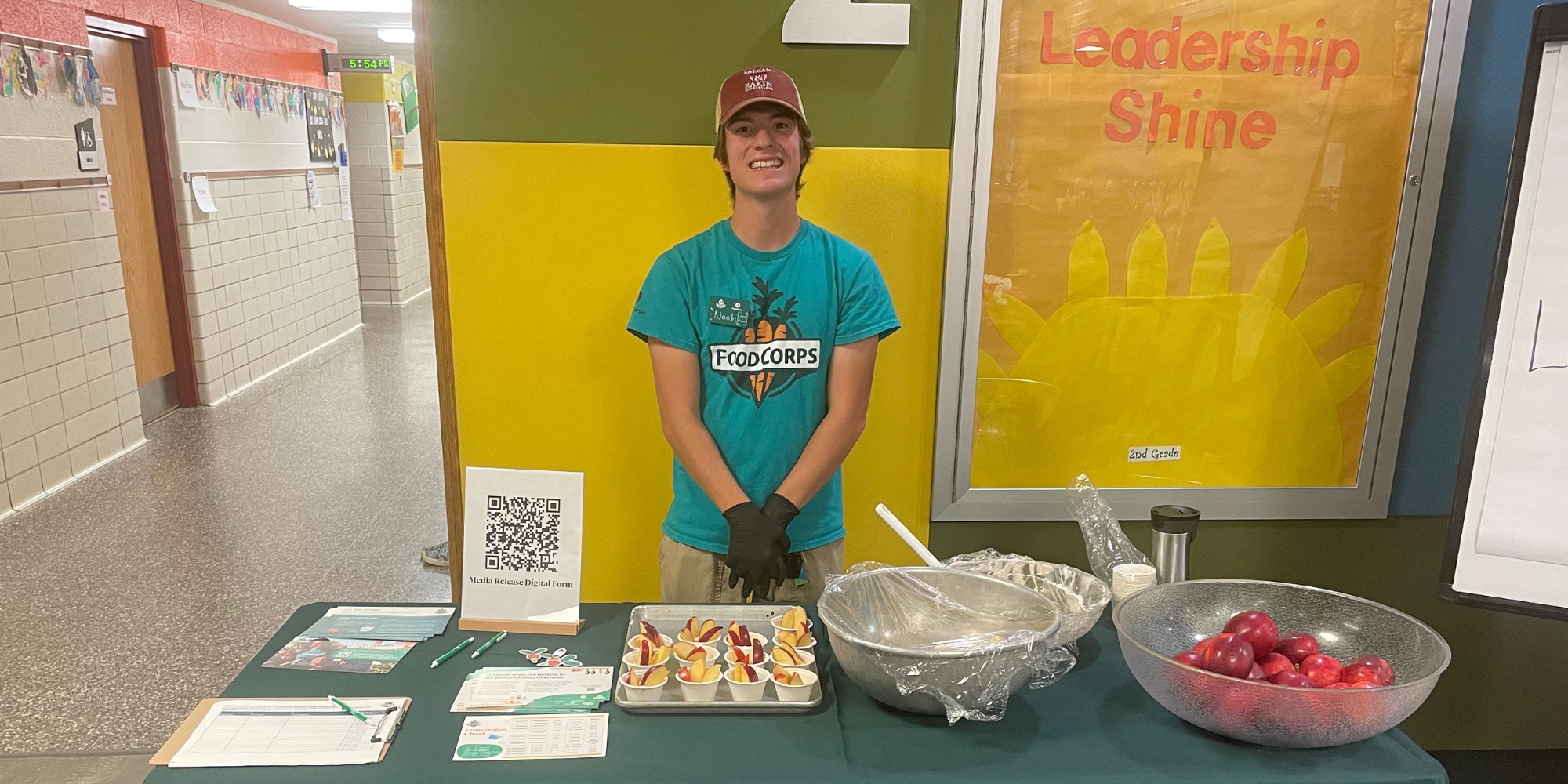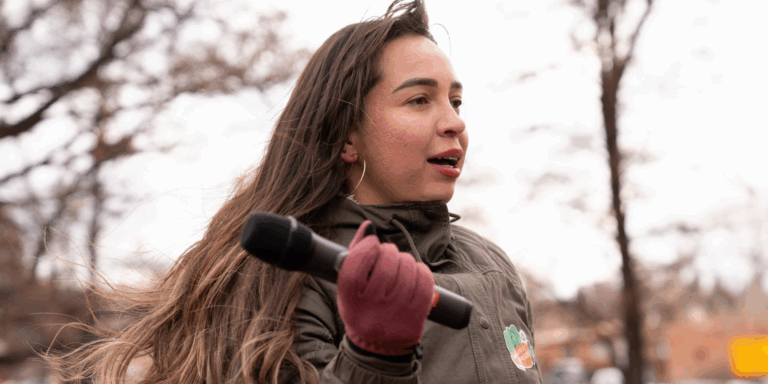A Day in the Life: Noah Doederlein, School Nutrition Member
A school nutrition member preps for a locally sourced taste test.
A school nutrition member preps for a locally sourced taste test.

What does a day in the life of a FoodCorps school nutrition member look like? Follow along as FoodCorps AmeriCorps member Noah Doederlein (MI ‘24, ’25) takes you through a school day.
I live in a house full of teachers and worked at a farm this summer, so I am no stranger to early wake-up times. I like to start my day with a few moments to ground and nourish myself before I head out, so I try to get up early on most days, though it doesn’t always work out like that. This morning I have a special class to get to at one of the schools where FoodCorps partners, so I make sure I don’t snooze my alarm this time around.
Commuting in northern Michigan on an October morning is a fiery display of red, yellow, and orange leaves; the last dregs of summer warmth traveling to tree roots for winter storage. Living in a more rural community means that many of the schools I partner with have smaller school populations while covering larger geographic areas than the average school. This morning I have about a 40-minute drive from my home in Petoskey, Michigan, to East Jordan—plenty of time to admire the change of the seasons.
Even though it is nestled in some of the best conditions for growing fruit and produce in the summer, local communities, like East Jordan, are not usually the first on the list to receive fresh, affordable food. Which is part of why I am here, so that more of those nourishing, whole foods come to our schools and strengthen our entire community!
When I get to East Jordan Middle/High School, I need to sign in for the day. One of the barriers that comes from working in multiple schools and school districts is that it makes it a bit more difficult to streamline my access to schools. Even though I spend at least two days a week in East Jordan, I still need to sign in as a visitor. I think this mirrors the separation between school nutrition departments and the rest of the school. It is an unfortunate byproduct of the system, and we work to overcome it every day.
Yesterday was Indigenous Peoples’ Day and today we have lessons planned with Spanish and Title VI (or Indian Education) classes about Maize/Maíz/Mandaamin across the Americas. We have the privilege of collaborating with the federally recognized Little Traverse Bay Bands of Odawa Indians tribe to support their efforts in revitalizing Odawa foodways in northern Michigan.
We have partnered with Amanda Weinert, the Ishkakimikwe (Teachings of Mother Earth) Curriculum Specialist, and Mary Donner, the executive director of the tribe’s non-profit farm, Ziibimijwang. Amanda and Mary’s knowledge and personal experience with traditional foodways, plus the access to schools and students that Angela Barrera, the Title VI Coordinator at East Jordan, and I can provide means that our collaboration can help realize the revitalization of Odawa foodways.
We were able to educate our students on the origins of Maize in northern Michigan, traditional ways it was used, and its significance to the Anishinaabe, specifically Odawa people. Plus, students were able to shuck and braid corn (a traditional and contemporary drying method), taste two different types of cornbread, and make a corn salsa.
Lunch today is spent in the high school cafeteria, which is a bit unusual since I normally try to spend lunch at the elementary school. Either way, it is a chance for me to lend a hand to the nutrition department staff, interact with students, and get a sense of how they feel about their lunches. Cultivating these relationships is an essential part of my work, and without doing so my previous term, I would not be able to work as well in my second year as a FoodCorps member.
Yesterday, I spent some time in the kitchen with East Jordan Middle/High School’s head cook preparing tomatoes, corn, onions, and peppers for the corn salsa we sampled during the lesson, and for Three Sisters and Pozole soups for lunch today. I have learned so much from all the food service staff who have taken the time to educate me on the ins and outs of school food and invite me into their space to provide opportunities to try for students. Students loved the samples and had an opportunity to celebrate Indigenous Peoples’ Day through revitalized foodways that we have worked to embed in our schools.
All the lesson materials need to be moved from the high school to the elementary school, so we hurry and load up our cars during a burst of rain and head over to do the same lesson with our younger students. It was amazing to see students light up at the variety of corn that exists and to hear them share their knowledge of it as one of the Three Sisters (corn, beans, and squash).
This evening there are also parent-teacher conferences. I had planned on hosting a taste test for students and parents, but was doubting if I had the energy to do so after such a packed day. But I had already bought all the materials for it and it won’t take long to cut some apple slices or mix up a yogurt dip with cinnamon and honey, so I thought, “Sure! Why not?” I certainly would not do this every week, but October is Farm to School Month (not to mention apple season in Michigan) and I want to make the most of it.
I was able to meet so many parents and make more connections with students that I normally only see during lunches! It makes me happy to have more low-stakes opportunities to talk with students and parents and provide them with new experiences that make affordable, fresh food more accessible. I made the mistake last year of thinking that every taste test had to be ambitious to make change. But the reality is that smaller taste tests help to build momentum and power among the school community to make change in our cafeteria just as much as larger taste tests.
Now it’s about time for me to wind down after a long day. Every day is different for a school nutrition member, and today has been particularly special.
Want to learn more about joining FoodCorps as a school nutrition member? Learn more about applying to FoodCorps.

The Policy Brief: Government Shutdown Edition

13 Foodie Halloween Jokes for a Scary Fun Time

Ask an Alum: Taty Trujillo in New Mexico